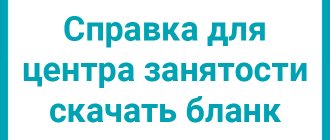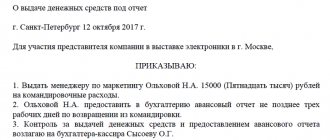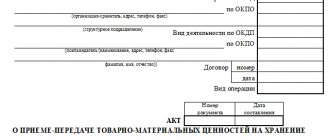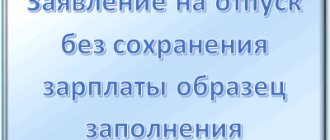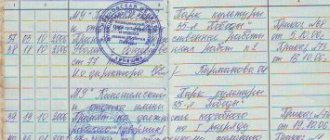What is a special assessment card for working conditions?
A special assessment card for working conditions is a document containing information about the employee’s place of work. To do this, you do not need to additionally use other documents.
It contains information:
- About the company where the certification is carried out.
- About an enterprise that provides services of a similar nature.
- Description of the work process.
- Parameters for measuring gas and dust levels in the air of the working area.
- Measurement parameters for noise, illumination and temperature and humidity conditions.
- What benefits are provided: shortened working hours, additional payments, additional leave, etc.
- How often are medical examinations carried out?
- What measures need to be taken to eliminate cases of injuries and occupational diseases.
A special assessment card for working conditions is a workplace passport, which contains all the comprehensive information about the employee’s working conditions in the organization. The employee must be familiar with the documents.
SOUT map (concept and legislative basis)
A special assessment card for working conditions is a documentary form containing information:
- about the labor situation at the enterprise;
- the results of measures to assess the conditions of labor functioning, taking into account the negative production phenomena present in the surveyed workplaces;
- classes (subclasses) of harmful working conditions;
- compensation guarantees for those working in unfavorable working conditions.
The SOUT map is an integral element of the reporting form, filled out based on the results of the assessment of working conditions in the workplace. The reporting form is contained in Appendix No. 3 to the order of the Ministry of Labor “On approval of the Methodology for conducting special. assessment of working conditions..." dated January 24, 2014 No. 33n. In addition, Appendix No. 4 to the said order contains instructions for filling out this form.
The regulatory document regulating the procedure for issuing SOUT cards is the Law “On Special Assessment of Working Conditions” dated December 28, 2013 No. 426-FZ, which established (Articles 15 and 16) the following:
- The map is generated for all workplaces.
- For similar workplaces, a single SOUT card is formed.
- The SOUT map form contains subsections that indicate:
- information about the company (name, tax identification number, activity code according to OKVED, territory code according to OKATO, etc.);
- information about the work area (name of the employee’s profession, name of the structural unit, information about similar places of work);
- number of employees;
- SNILS of employees;
- analysis of working conditions taking into account unfavorable production factors;
- data on compensation benefits provided to employees;
- proposals for improving working conditions;
- date of card formation;
- signatures of the commission members, its chairman, experts, as well as employees at whose workplaces the research was carried out.
If this document is missing
The employer must have a special assessment card for working conditions, and in its absence, the consequences may be different. Based on the requirements of labor legislation and Federal Law, this work is required. Every five years a special assessment of working conditions must be carried out.
Failure to comply with these requirements will result in administrative penalties for the employer. It turns out that the employee is working in a workplace where it may not be possible to work. The reasons may be non-compliance with sanitary standards and unfulfilled compensation assessments, and in the event of an accident, an assessment of hazardous factors was not carried out.
Quantitative calculations
To perform error-free calculations, it is necessary to understand how many workers are involved in one workplace at the same time. If an organization employs 3 accountants at the same time in the same temporary mode, without shifts or rotations, then 3 jobs for the position “accountant” are included in the list of jobs for the SOUT.
If we are talking about 4 security guards working in the “every day after three” mode (4 workers replace each other - there is only one guard at the workplace at a time), the list for SOUT reflects only one workplace in which 4 people work in shifts.
Most often, errors occur when adding workplaces with the same name, equipment, premises, as well as non-stationary workplaces, especially those with shift or rotational work, to the list. You can avoid miscalculations by adhering to a simple rule - the number of workplaces is equal to the number of employees simultaneously working on it.
For example, 6 milling operators work in 2 shifts on 3 machines in one workshop. During the shift, each milling operator alternately works on all three machines, which means that 3 jobs are included in the list. If they meet certain criteria, these jobs can be recognized as similar, which will minimize expenses on special equipment.
This is interesting: Inventory protocol sample filling 2020
To simplify the preparation of the list of workplaces, members of the SOUT commission equate the number of pieces of equipment to the number of workplaces. This approach may be appropriate in some situations, but it will be wrong if:
- one employee uses more than one piece of equipment;
- two or more workers use the same equipment at the same time.
The same can be said about non-stationary workplaces, the work areas of which may change geographically. Non-stationary workplaces with the same name cannot be regarded as one workplace.
How to prepare a special assessment card
Map preparation is carried out in several stages:
- The number of jobs to be assessed is determined. As a rule, this work is entrusted to the HR department.
- A list of jobs is compiled, signed by experts and approved by the organization’s management.
- An administrative document on the work is being prepared. Enterprise specialists are appointed members of the commission, and the head of the facility is appointed chairman.
- Next, the work of the expert commission begins together with the management team.
- Based on the results of the work, a map is drawn up. And so on for each place.
- The list of facilities at which a special assessment of working conditions was carried out is also agreed upon with specialists and approved by management.
What jobs are subject to special assessment?
Despite the fact that the List is drawn up by a Commission, which should include representatives of the employer, a labor protection specialist and a member of a trade union organization, in practice it turns out that the document is not always drawn up properly and it does not always correctly identify the number of jobs subject to SOUT. One of the main reasons is the lack of qualified personnel in the area of labor protection in organizations. Another, ambiguous understanding of the requirements of Federal Law No. 426-FZ.
When independently determining the number of workplaces subject to assessment, the commission members believe that office workplaces are not subject to assessment. This is due to the approval of Order of the Ministry of Labor No. 590n under the previously existing assessment procedure - certification of workplaces (AWC, - ed.), where certification was not mandatory for workplaces of employees whose work was related to personal computers, copying machines and other household and office equipment, provided that the employee is working on a PC less than 50% of the time. Today, this Order, like the automated workplace itself, has been cancelled, so these rules do not apply to special assessments.
In accordance with Federal Law No. 426-FZ, all workplaces ( including those of office employees ) are subject to special assessment, with the exception of workplaces of homeworkers, remote workers and workers who have entered into employment relationships with individuals who are not individual entrepreneurs. It is a mistake to believe that, for example, a homeworker can be considered an employee who performs work at home, remotely, but at the same time the employment contract with him was drawn up on a general basis without taking into account working conditions. Employment contracts with homeworkers must take into account: the employer’s responsibilities to provide equipment, tools, working conditions at home , terms and methods of payment of wages, and the employee’s responsibilities to provide results within the specified time frame. These conditions will be the basis for not conducting a special assessment.
This is interesting: Sample report form on the use of customer-supplied materials
Filling algorithm
The special assessment card for the labor process is filled out sequentially. For this, the following information is taken into account:
- All information about the company conducting the certification. Name, address, location, license number and certificate of right to engage in this type of work.
- Data about the workplace and similar places.
- Indicate the SNILS number of employees.
- What negative environmental factors exist, how do they affect the body.
- What compensation are due to employees for harmful production conditions: a shortened day, how many days the vacation is increased, what amount of additional payment is due.
- List of measures according to which working conditions are improved.
- This information is provided from the company's certificate of incorporation, state schedule. The bulk of information is entered into the cards by experts, as well as by the management of the enterprise where the special assessment was carried out.
- Information from the administration data
SOUT card: sample filling
In this article we will figure out what it is and why you need a SOUT card.
The filling template will help you enter the data correctly. A special assessment card for working conditions is a document that records data on working conditions in the workplace. A special assessment card for working conditions is filled out for workplaces and included in the list of documents provided based on the results of the special labor assessment.
What is the purpose of the SOUT card?
The SOUT map includes information:
- due to unfavorable factors;
- classes of working conditions;
- types of guarantees and compensations provided to employees;
- proposals to improve working conditions.
During employment and during the course of work, employees must be informed of the presence of a SOUT card. Read more about special assessment in the articles “What is SOUT” and “Carrying out SOUT”.
During control checks, inspectors from supervisory authorities study the map and the results of the special assessment. They evaluate the condition of the workplace and the firm's compliance with guidelines to improve the quality of working conditions. This data is summarized in the SOUT map. It is filled out based on the results of the analysis of the production sector.
A special assessment card is drawn up for workplaces where measurements of production environment factors were made. For places where no harmful components of production have been detected, a special assessment map is not drawn up.
How to fill out the SOUT card
Information is entered into the special assessment card based on the conclusions of the experts of the special assessment commission. The card is filled out according to the prescribed form.
Filling out the header
- We enter the full name of the company, address, full name of the management, email address and other information in the cells.
- We enter the company codes: INN, OKATO, OKPO, OKVED, OKOGU, OKVED. A sample of filling out the SOUT card is given below.
- We fill out the number and enter information about the number of employees and the work performed.
- We enter information about jobs for SOUT in the table. All positions and professions are entered in accordance with the All-Russian Classification of Professions of Workers and Positions of Employees (OK-016-94).
Inaccuracies in filling out this item lead to the fact that the worker does not receive the compensation due to him.
We enter the SNILS number of employees
We indicate the numbers of insurance certificates of employees who work in the company.
Fill in the field about the company’s equipment
We list the available equipment, materials and raw materials. We enter the names: welding machines, lathes, computers, sorting mechanisms.
An example of filling out a special assessment card for working conditions is given below.
How to reflect data on adverse factors
We enter data on unfavorable factors in the workplace into the table. We indicate the class of working conditions.
How to reflect data on guarantees and compensations
If unfavorable working conditions are identified, we provide information on guarantees and compensation payments. We prescribe the grounds for introducing compensation in accordance with legislative norms. We list all guarantees and benefits, referring to the regulatory framework.
Making recommendations to improve the quality of working conditions
At the final point, the cards make proposals to improve the quality of working conditions. In order to reduce the negative effects of unfavorable causes. The commission enters into it instructions that the company is obliged to implement. If no instructions have been issued, write “no”.
Signature by the members of the special assessment commission
The map is approved by commission members and special assessment experts. After this, each employee is familiarized with the document. Employees must sign.
Introducing staff to the results
All workers at the workplace agree with the results of the special assessment for the workplace, not excluding workers who use the workplace for one-time operations.
An example of entering data into a special assessment card for working conditions
When filling out the card, use the instructions in the appendix. No. 4 to Order of the Ministry of Labor dated January 24, 2014 No. 33n.
Documents for SOUT, sample filling:
How to enter SNILS into a special assessment card
In line 021, enter the data of all employees on SNILS. If the number of lines is not enough, additional lines are added.
Informing workers about the special assessment card
Upon completion of measurements and examinations, workers are provided with a special assessment card. After review, each worker signs and agrees with the results.
Where is the special assessment card stored?
The place or department of the company where documents with the results of the special assessment are stored is determined by the company independently. When a company has a labor protection service or specialist, the data is stored there. If services or an employee are absent, special assessment cards are stored in the personnel department or in the accounting department.
Information about the organization, employees and their insurance certificates
The first step is to fill out the information by the enterprise administration, that is:
- Information about the manual.
- Full name of the organization.
- Where is the enterprise located?
- Information from the passports of managers and superiors.
- Contacts of the facility management.
- Other information based on the table requirements.
- Card number, information about employees, positions
It is required to enter information about the number of employees in workplaces that require a special assessment. It indicates what positions and job functions the employees perform. The staffing table is taken as a basis, and the numbers are indicated in order.
Based on the data from ETKS, the details are filled in. The table below fills in the actual information.
Filling out is carried out by personnel service employees, health and safety specialists.
Afterwards, the information from the employees’ insurance certificates is filled in. But the table provides for filling in other lines that are left empty before a new employee is accepted into the organization.
Filling out is carried out by the HR department.
Where is the special assessment card stored?
The place or department of the company where documents with the results of the special assessment are stored is determined by the company independently. When a company has a labor protection service or specialist, the data is stored there. If services or an employee are absent, special assessment cards are stored in the personnel department or in the accounting department.
Information about changes:
By Order of the Ministry of Labor of Russia dated September 7, 2020 N 602n, changes were made to the application
GUARANTEE:
See this form in MS-Word editor
Appendix No. 3 to the order of the Ministry of Labor and Social Protection of the Russian Federation dated January 24, 2014 No. 33n (as amended September 7, 2020 November 14, 2020)
Report on a special assessment of working conditions
Title page of the report on the special assessment of working conditions
Registration number of the organization's accreditation certificate
Date of issue of the organization's accreditation certificate
Information about equipment and raw materials
The next step in the experts’ work will be to establish information about the equipment and materials used in the production process.
To do this, information is requested about:
- Models of machine tools, personal computers, lifting equipment and other equipment on which work is performed.
- Information about the materials: name, what operations are performed, what are the emissions of harmful substances to one degree or another, are there any excesses in terms of harmful factors.
- The expert organization requests data from the management of the facility, studies literature in these areas, and takes measurements.
Harmful and dangerous production factors
Harmful and dangerous factors are two different things that should be clearly distinguished from each other.
A harmful factor has a detrimental effect on the human body through the respiratory, hearing or vision organs. This includes noise, insufficient lighting, and excessive levels of gas or dust as a result of the release of harmful substances.
For example, in the workplace, toluene is used in paint production. This chemical element has a harmful effect on the body, since its excess in the air of the work area is 1.1 times higher than the norm. Exceeding the noise level also plays a negative role in its impact on the body. Ultimately, there is a risk for an employee to become ill under the influence of factors of this kind, including an occupational disease.
Hazard is a factor that poses a threat to life or health to a person. For example, explosive substances are used at the work site. It turns out that it is dangerous to be near them, since they can detonate and a person will be injured as a result.
Making changes to the SOUT map
Recommendations for the initial formation of the map are described in sufficient detail both in the instructions (Appendix No. 4 to Order No. 33n) and in various explanatory articles on this topic. However, later, for example, when the personnel composition of an organization changes (the dismissal of some employees and the hiring of others), it may be necessary to change information about the SNILS of employees.
By letter “On the procedure for adding employees to SOUT SNILS cards” dated May 25, 2015 No. 15-1/B-1929, the Russian Ministry of Labor explained the procedure for making such adjustments. Its essence is as follows: replacing data on SNILS in the SOUT card can only be done after the next SOUT activity has been carried out at a specific workplace. At the same time, new employees and members of the workforce temporarily transferred to this place must be familiarized with the data based on the results of an assessment of working conditions at their work site. The fact of familiarization is confirmed on the card with the signatures of new employees.
Also, the Ministry of Labor in the specified letter informs that work is underway to make changes to the reporting form for SOUT and instructions for filling it out, the result of which should be, among other things, an updated procedure for entering SNILS into the card. The draft changes involve entering the employee’s data at the time the employee familiarizes himself with the results of the conducted SOUT. However, at the time of writing this article (end of 2020), such adjustments have not been made to the regulatory framework.
As you can see, the process of filling out the SOUT card is not particularly difficult. However, this requires attention to detail due to the need to provide a large amount of accurate data.
List of compensations
Compensation is provided for workers for work under special conditions:
- For exceeding harmful factors . After taking measurements of gas pollution, noise or dust levels, it turned out that the employee was working in excess. It is calculated how many times excesses are allowed. Based on what is received, the payout percentage is set. Typically from 4 to 12%. Accruals are made depending on the minimum tariff rate for the time actually worked.
- Depending on the type of work or profession, the time for additional days of vacation is established. For this purpose, there is a document regulating this circumstance.
- A shortened working day is also established for work in hazardous conditions based on standards.
- Preferential retirement experience is provided to the employee based on the norms.
All information is recorded in a card for a special assessment of working conditions and is taken as a basis when calculating compensation or providing additional rest time. That is, the concept of “additional payment for harmfulness” can be different.
Schedule for carrying out SOUT in 2020 - sample filling
The obligation to draw up a work schedule is provided for in Part 1 of Art. 9 of Law No. 426-FZ. It can be issued as an annex to the order to conduct special assessment work, or approved as a separate document. There is no unified form; employers can develop the schedule form themselves.
What needs to be included in the schedule:
- description of the stages of work within the framework of the special assessment;
- deadline for each stage.
The schedule is drawn up indicating the time required to complete each type of work (start/end dates or number of days). It is advisable to immediately provide a little more time than required, otherwise a failure in one of the periods will entail a violation of the deadlines for the next stages. The special assessment schedule should take into account the specifics of the enterprise:
- shift;
- operating mode;
- number of places for evaluation.
The manager appoints persons responsible for meeting the deadlines for a particular event.
An approximate schedule for conducting the SOUT - a sample of filling out 2020 can be seen below.
Recommendations on how to improve conditions
Based on the results of the work, experts provide information on improving working conditions. How it's done:
- An assessment is made of the risk of injury at the workplace. For example, where an employee may fall or an excess of a harmful factor is established. Then additional measures are prescribed: repair the floor covering or wear a respirator.
- Measures to reduce the level of danger are set out in a special plan, which is agreed upon with the management of the facility and must be completed in accordance with the deadlines.
- Activities that do not require costs are usually carried out in the near future. Those activities for which funds need to be spent are carried out at the time agreed with the employer.
- After signing the measures, the injury hazard class to which the workplace belongs is indicated.
Commission members
When preparing an organization to conduct a special assessment of workplaces, an administrative document is initially issued, which indicates the members of the commission in the organization. The commission includes:
| Commission members | A comment |
| Head of the facility | This is the chairman of the commission. He organizes control over the certification process and approves documents. In case of disagreement, organizes meetings at which all controversial issues are resolved. |
| HR Representative | Prepares a list of employees and a list of workplaces where certification is planned to be carried out. After approval of the list, work begins. |
| Health and Safety Specialist | Controls the certification process and helps commission members correctly assess the employee’s position, provides the commission with available documents on occupational safety upon their request, including administrative acts, instructions, personal cards for issuing personal protective equipment and training. |
| Chief power engineer and chief mechanic | Specialists are needed to show work sites and equipment on their farm. |
| Other specialists and managers of sites and facilities taking part in the certification. |
Members of the commission and the chairman must be familiar with the order to carry out work against signature. It is important that the date is placed next to the signature.
Name of workplace for SOUT
Correctly entering the names of jobs into the list is as important as the correct number. According to the instructions approved by Order of the Ministry of Labor of Russia dated January 24, 2014 No. 33n, the name of the position in the documentation for a special assessment of working conditions must completely coincide with its counterpart recorded in the staffing table of the enterprise.
It happens that the commission, for reasons of trade secrets, provides the expert organization on SOUT with a list of jobs that does not correspond to the original staffing table. However, in the process of further application of the results of the special assessment when assigning benefits and guarantees, it turns out that not all jobs were covered by the special assessment.
In such situations, inspections may turn into legal proceedings, leading to the conclusion that the implementation of the special assessment system is incomplete due to the lack of information on individual positions. Such oversights can only be avoided by carefully monitoring the coincidence of the names included in the SOUT materials with the positions recorded in the current staffing documents.
The same problem is often faced by organizations that undergo restructuring to optimize their business. The process, as a rule, is associated with changes in job titles without noticeable changes in working conditions and job responsibilities.
Many employers do not see any reason in this situation to conduct an unscheduled SOUT. But they are mistaken, since the names of positions in the list of SOUT often do not coincide with their counterparts in the new staffing table and other documents.
Within the framework of the SOUT, these workplaces were recognized as one and the same workplace. To confirm this circumstance, the expert organization that carried out the assessment activities wrote a corresponding letter. However, the court did not accept the justification of the employer and the expert organization due to the lack of assessment materials on the jobs of the first, second and third watch mate.
The final conclusion of the court decision indicated that there was no legal basis for distributing the results of the automated work system to “positions with similar or identical job responsibilities available in the staffing table,” since such a possibility is not provided for by the Procedure for conducting the automated work and special labor requirements.
Organizations for which frequent change is the norm face more complex challenges. Even in the process of carrying out the special operational assessment, they have to adjust the staffing schedule many times. Experts recommend that members of the special assessment commission and occupational safety engineers of such organizations must necessarily bring to the attention of management the financial consequences of the reforms they are carrying out.
They should know that in accordance with Federal Law No. 426-FZ, for each new position an extraordinary special assessment is required within six months from the date of its introduction. In principle, any changes in the staffing table related to the name of the position are grounds for conducting a special assessment outside the schedule.
About getting acquainted
It is necessary to familiarize yourself with the employee’s certification card; there are several compelling circumstances for this action:
- This is a requirement of regulatory and legislative documents.
- The employee must know what compensation and benefits he is entitled to and for what reasons they are not determined.
- It is important to know whether you need to undergo medical examinations and how often.
- What harmful factors are present in the workplace and measures to combat them.
- List of personal protective equipment used in the workplace.
- Safety measures that the employee must know, including training.
- Regulations on work, duration of lunches and work breaks.
- Length of working day and vacation.
Sample card
How to fill out the special assessment card correctly:
- The name of the expert organization that carried out the certification is indicated: details, legal address, index.
- Information about the employer: insurance certificate TIN, organizational structure codes, address, zip code, registration certificate number.
- The number of places for which conditions are assessed is indicated. This information is provided by a specialist from the HR department, as well as information about the structural unit.
- How many employees work in the workplace, including women, the number of persons under the age of majority, SNILS number of employees.
- What equipment and materials are used in the technological cycle.
- What payments and benefits are due?
- A class for assessing working conditions is established in accordance with legal requirements.
Where is the SOUT card stored?
The place or structural unit where documents based on the results of a special assessment are stored is determined by the employer independently by its regulations. If the organization has a separate position or occupational safety service, then the specified documents will be stored there. If there is no corresponding specialist in the organization, then the SOUT cards will be stored either in personnel or in the accounting department (according to the principle - whoever directly organized it keeps it).
Since 2014, Russia has had a law that obliges employers to conduct a special assessment of working conditions (SOUT). This is not an absolute innovation; previously, workplaces were certified in order to determine harmful and dangerous working conditions, to accrue benefits and compensation for a certain category of workers.
Special inspections of workplaces to identify dangerous or harmful factors for the life and health of employees are carried out by companies with state accreditation .
Storage and modifications
The special assessment card for working conditions is kept by the employer, usually in the personnel department. Storage is carried out for five years, that is, until the next certification. The document is presented at the request of management and supervisory authorities.
Changes and additions are not made to the SOUT map, since periodic assessment work is required in the following cases:
- After five years, the next certification is carried out.
- If changes have been made to the technical process or new equipment has been purchased, then experts must be involved in the assessment again within 6 months.
- When organizing a workplace, certification is carried out again after a year.
No changes are made to the special assessment card for the conditions of the labor process; the document is drawn up again. This is a requirement of regulations and regulatory documents.
Which positions are not subject to SOUT?
Let's look at the list of professions and positions that are not subject to SUT. Such a list is established by clause 3 of Art. 3 laws 426 Federal Law:
- homeworkers;
- remote workers;
- employees who began working with an employer who is an individual and is not an individual entrepreneur;
- vacant jobs. A special assessment is carried out after hiring an employee.
Telecommuter
Thus, the answer to the question of which places are subject to SOUT is presented in 426 Federal Laws. According to the law, it is carried out in all workplaces, in all types of companies, regardless of the field of activity, form of ownership, size, etc. There are small exceptions. All employers must organize work according to SAW.




